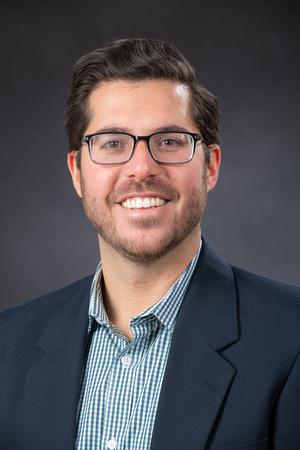Inaugural grant program funds will support sustainable viticulture and improve stormwater infrastructure
Recipients of AGNR’s Advancing Our Strategic Initiatives Fearlessly Forward grant program have been selected. Two faculty members will receive approximately $125,000 each for research that will have an impact in many of the college’s five strategic initiative areas. The grant program was rolled out for the first time this year and is intended to advance AGNR’s strategic initiatives in new and creative directions.
“It is exciting to see our faculty developing innovative projects that really embody what’s important to the AGNR community,” said Dean Craig Beyrouty. “We are proud to be able to back them up with real financial support because, every step our researchers take in advancing our strategic initiatives is a step forward for the college, for students who want to be engaged in meaningful research and for the global community where we are making an impact.”
Dr. Beyrouty also said the grant program will be offered again next year.

Ryan Blaustein, an assistant professor in the Department of Nutrition and Food Science is leading a project that will merge components of the AGNR strategic initiatives to Establish a Healthy Food System, Advance Sustainable Agricultural Production, and Improve One Health.
His project titled: Bio-based Innovations for Viticulture and Fermentation: Sustainable Production from Farm to Glass, aims to develop biologically inspired solutions to enhance the rapidly growing fermentation industry.
“The team and I are grateful to receive an inaugural AGNR Fearlessly Forward award,” Blaustein said. “We thank the college leadership for promoting the strategic initiatives in a way that brings diverse faculty expertise together to synergistically address important problems and critical needs for agriculture in Maryland and beyond. The innovative program has sparked exciting new collaborations for our team and throughout the college.”
Blaustein and his team will establish a database on viticulture production in Maryland, incorporating data on climate conditions, soil properties and crop management practices in order to develop predictive models that can inform weather-based crop management recommendations in the state.
They will also develop a catalog of the microorganisms associated with wine grapevines throughout the state. Like people, plants have a microbiome—a community of bacteria and fungi that live in and on a plant and the surrounding soil. The microbiome interacts with a plant’s reproduction, growth, health and immunity, which means the microorganisms may be harnessed to benefit yields or protect a plant from disease and pests.
The project aims to identify microorganisms within Maryland wine grapevine microbiomes that might be used as biological alternatives or augmentations to chemical pesticides. In addition, the team will explore the potential for some of the organisms in the wine grape microbiome to assist in the fermentation process and improve wine quality.
Education and Extension activities are integrated into the program, as the team will incorporate developments from the project into course programming across various departments, provide opportunities for student participation, publish fact sheets for growers and participate in appropriate conferences. The program will elevate student interest and activity in UMD’s new Fermentation Science program and build strong connections with local industry.
In addition to Blaustein, the team consists of the following AGNR faculty:
Department of Food and Nutritional Science: Rohan Tikekar, Behrouz Meyssami, and Abani Pradhan
Department of Plant Science and Landscape Architecture: Diana Cochran and Mengjun Hu,
Wye Research and Education Center: Joe Fiola from WMREC.

Mitchell Pavao-Zuckerman, an associate professor in the Department of Environmental Science and Technology is advancing the initiative Optimizing Urban Environments with his project titled: Maximizing the multifunctional co-benefit potential of stormwater green infrastructure to optimize urban environments.
“We are very excited that the college is supporting our project on green infrastructure to bring together ecology, environmental health, and green design to improve our urban environments,” said Pavao-Zuckerman. “This research funding for the strategic initiative benefits faculty and students in AGNR and supports us to do work that connects to communities in meaningful ways.”
Pavao-Zuckerman and his team will investigate how the design of green infrastructure affects the benefits and ecosystem services it provides in urban environments in Maryland and Washington D.C. Green infrastructure is primarily designed to manage stormwater by reducing runoff and retaining pollutants. These systems can prevent damaging flash floods and erosion, and protect waterways from pollution and sediment runoff.
But as holistic ecosystems, green infrastructure can also confer ‘secondary’ benefits, such as providing habitat for wildlife, increasing greenery in urban settings, helping sequester carbon, reduce radiative heating and regulate microclimates. Different design principles and maintenance methods vary in the value and emphasis they place on these additional benefits, which means green infrastructure may function very differently depending on whether it was designed by a landscape architect, civil engineer or non-profit organization, and how it is being maintained.
Pavao-Zuckerman’s research will compare green infrastructures in the Anacostia watershed that are designed by different practitioners or that have different maintenance histories over their lifespan to see how they support different ecological functions.
The researchers will measure data that tell the team about stormwater management (infiltration, pollutant retention) and about other ecosystem services (plant growth, species diversity, carbon storage, temperature, aesthetics). The goal of the study will be to learn how different maintenance strategies can be used to optimize the ecosystem services provided by green infrastructure systems.
Pavao-Zuckerman and his team intend to connect with students, communities, and practitioners through integrated Education and Extension activities. The grant will support graduate student research assistants and provide opportunities for undergraduate researchers and course modules. Planned Extension activities include the production of fact sheets, modules for the Chesapeake Bay Landscape Professional certificate program, and presentations to regional management, policy, and community organizations that work in stormwater management and urban ecology.
In addition to Pavao-Zuckermen, the team consists of the following faculty:
Department of Environmental Science and Technology: Jennifer Mullinax
Sea Grant Extension: Amanda Rockler
School of Architecture Planning, and Preservation: Marccus Hendricks
Environmental Science and Technology PhD candidates supported by the grant: Rahat Sharif and Qianyao Si